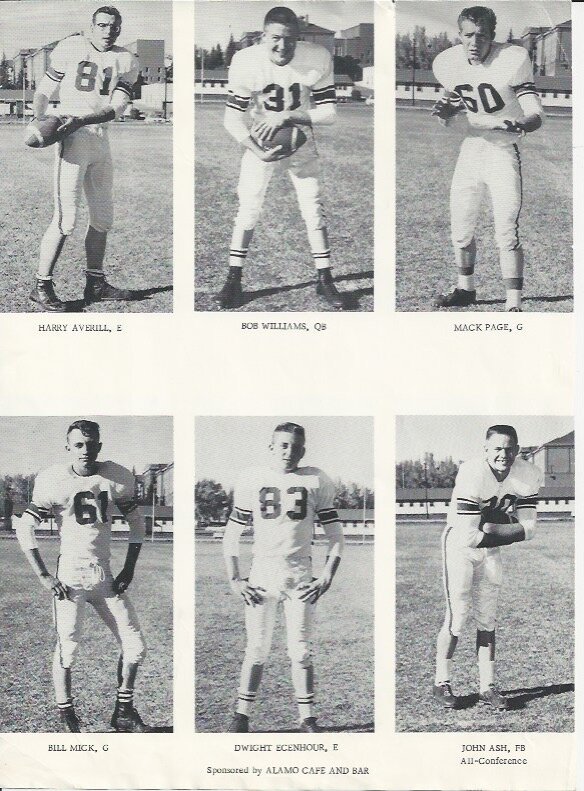A Famous Name and a Generous Heart
By Katie Frohling
Dwight “Ike” Icenhour
July 25, 1944-June 8, 2016
Dwight Icenhour was born on July 25, 1944 in Gunnison, Colorado, a tiny town of 6,000 residents in the foothills of the Rocky Mountains.[1] When Dwight was just three years old, his parents divorced and his father left their home. His father was absent for much of Dwight’s life. Living with his three sisters and mother, Dwight became the “man of the house” early on; he worked at his uncle’s gas station in town to help pay the family bills. His grandparents were monumental in his life growing up, especially his grandfather, who served as his primary male role model.
Dwight graduated from Gunnison High School in the spring of 1962[2], with a graduating class of just 62 students, a testament to the size of the town. Although he was not from a military family, Dwight, along with three other friends from school, went to enlist in the Navy on July 24, 1962. This was the day before his eighteenth birthday, which resulted in Dwight being considered a “Kiddie Cruiser.” This was a term given to those who enlisted before their eighteenth birthday.[3] After seeing the environment of his upbringing, which included a lot of small-town problems such as drinking and dysfunction, Dwight was determined to get out of Gunnison. He chose the Navy specifically because he hoped, by selecting this branch, he would have the best shot of seeing exotic places and having worldly experiences.[4]
Dwight Icenhour (pictured bottom row, center)
Dwight soon became Ike during training, where he took some introductory courses in San Diego and then spent the rest of his training in Pensacola, Florida. Those closest to Ike recall him describing his time training as simply “rolling with the punches,” as these early months were full of new information. Besides taking tests, Ike and his friends were able to take small trips when they were on leave, such as going to Mobile, Alabama. For Ike, who spent his entire life in a mountain town in Colorado, getting to do a weekend trip to Alabama with buddies was him living out his dream of seeing more of the world.
During his time in the Navy, Ike was a PH3, which is the Photographer’s Mate Petty Officer 3rd Class. When enlisting, Dwight, always thinking ahead, thought he should learn a trade for later in life, hence his reason for choosing this position. The main responsibilities of this team are to essentially document the Navy and its activities, using cutting-edge technology. Ike’s job was to help carry, transport, and load huge cameras onto the aircraft carriers. His only complaint was that it was virtually impossible to fall asleep with the sound of the loud carriers in the background,[5] which surely made him appreciate his bed much more once he returned home.
Although there is no official record of Ike’s assignments, his widow Barbara is sure Ike was on both the USS Hancock and the USS Coral Sea. These ships were two integral parts of the Seventh Fleet, a Navy formation that, “During the Vietnam War, [...] engaged in combat operations against enemy forces through attack carrier air strikes, naval gunfire support, amphibious operations, patrol and reconnaissance operations and mine warfare.”[6] On February 7, 1965, the USS Coral Sea, in conjunction with USS Hancock and USS Ranger, blasted the barracks and staging areas in Đồng Hới, in North Vietnam, in response to strikes made by the Viet Cong against Americans in South Vietnam. These were obviously stressful situations, especially since these campaigns were some of the most monumental in the United States’ involvement with Vietnam. The USS Hancock was even famous among the Navy, as it “...was the first carrier to receive the Navy Unit Commendation for both WWII & Vietnam.”[7]
Ike’s time on these ships facilitated the travel experiences that he sought out when originally enlisting. During his three years in the Navy, Ike was able to travel to exciting places like the Philippines and Japan. He often told stories of exploring new towns and cities, meeting residents, and trying local cuisines. One particularly memorable experience for Ike was trying Balut, a developing duck egg embryo that you eat from the shell, which is a famous Filipino street food. These adventures are precisely what drew Ike to the Navy and they are the events that he often spoke about in letters he wrote home.
In July 1965, Ike’s time in the Navy was over, and although he seriously considered re-enlisting for another tour because he was still so young, he decided to go home to Colorado and start the next phase of his life. He attended Western State College, now named Western State Colorado University, in Gunnison, Colorado. Western State was also the place where Ike met his future wife, Barbara. In the fall of 1965, on the first day moving into dorms, Barbara and a girl from her hall went into town to buy more clothes hangers. While they were walking back to school, another college student pulled over and offered them a ride back to the dorms. The only thing was that he had to stop by where his friend was working quickly and give him details on the night ahead. The girls accepted the ride and the young man drove them to a gas station where Barbara was introduced to Dwight Icenhour. Quickly, Barbara remembers responding with something sassy like, “Yeah, and I’m Marilyn Monroe!” Their silly exchange helped break the ice and then the four of them went out on an impromptu double date. After that night, Barbara and Ike were a couple.[8]
Just a year later, on September 2, 1966, Barbara and Ike were married, Barbara was 19 and Ike was 22. They decided to get married because a disciplinary incident prevented Ike from returning to Western State for his sophomore year. Although Ike was taking the year off and working, Barbara was still in school and the pair wanted to live together. Barbara felt safe and comfortable with Ike for many reasons, one being that since he had already served, she knew he would never be drafted, like so many of their peers at the time.
While at Western State, Ike was an avid member of the Veterans Club, which met once a week. This was an organization that was comprised of all former servicemen, and focused on civic engagement and local philanthropy. For example, for holidays or celebrations, the group of young men would decorate the town with flags or participate in parades. The Veterans Club was also an amazing network of support for Ike because it was composed of individuals who had similar experiences and understood the unique struggle that comes hand in hand with reintegration after military service.
Once Ike was back in school, he and Barbara took advantage of the G.I. Bill, specifically the portion that aids in college tuition cost.[9] This helped them tremendously, as it covered Ike’s tuition, so the pair could focus on financing Barbara’s education. During school, Ike continued working at a gas station and Barbara worked in the graduate office. Their hard work and smart saving tactics allowed them to purchase an 18-foot mobile home. It was at this exact home that, when Ike was 25 years old, his father knocked on the door, apologizing and asking for forgiveness. A kind man, Ike was able to not only establish but to maintain a positive relationship with his father for the rest of their time together, unlike his siblings. The compassion that radiated from Ike is on full display in his decision to, after 22 years, accept his father’s apology and move forward.[10]
In 1969 Barbara graduated from Western State with a degree in Elementary Education. In 1970, Barbara graduated with a Master’s in Education and Business, while Ike graduated with a degree in Business. It was during this senior spring of 1970 that Ike interviewed with several companies. One day, Western State brought in State Farm representatives to come conduct interviews. Ike, although interested, was adamant about not wanting to be an agent. He was able to find another position that suited him, which was that of an underwriter. The main responsibilities of an underwriter are to evaluate the risks that the insurance agents are taking on, which is what Ike did in the Greeley, Colorado office while he and Barbara remained in Denver.
Soon, State Farm was opening a regional office in Arizona and they were looking for motivated, ambitious employees who were willing to relocate. Barbara and Ike discussed it and packed up and moved out to Tempe, Arizona, where they stayed for five years. Barbara reflects on this major change in residency, saying it was a “great move for us.” It was here, too, that Barbara and Ike could start their family, having their daughter Lisa and then their first son Mark. Despite being new to parenthood and scared of making mistakes, Barbara described Ike as “natural” dad, easing into his new role. Then, only two days after the birth of their second child, Mark, Barbara and Ike moved to Albuquerque, New Mexico. Their family headed to New Mexico after Ike, making quite a name for himself with State Farm, was promoted to a field underwriter position, which mainly focused on business properties. After a year and a half, though, Ike noticed he was doing the work of an agent, but without the commission checks. This realization led him to want to become an agent after all, which Barbara supported, as long as they could move back to Colorado.[11]
Ike, Barbara, and their two children, soon to be three, moved to a home in Littleton,[12] so Ike could easily work in the Denver office. Their family stayed in Littleton for fifteen years and it is where Ike and Barbara’s kids were raised. The children enjoyed typical neighborhood fun and both Barbara and Ike got to be closer to their families. Ike also loved spending summers at Lake Powell with family and friends, relaxing. When their kids were grown up, however, Ike suggested a big move to Barbara, to a more rural town, where they would have plenty of space and privacy. The pair settled on Bennett, Colorado, because they fell in love with a house there. Here, Ike found solace in tending to their land, whether he was mowing the lawn in the spring or using the snow blower in the winter. One of Ike’s most prized-possessions was his well-maintained, elaborate fish tank, which he kept in his office. After being there thirteen years, Barbara and Ike jointly decided it wouldn’t be good to continue to isolate themselves so much in the country. Once again, they found themselves moving close to Denver, in Aurora, Colorado. In fact, Barbara still lives in the same house today, claiming that Ike bought it for her and her future.[13]
What is so amazing is that even after Ike was diagnosed with pancreatic cancer, he never retired from State Farm, which is further evidence that he was such a loyal employee. A lifetime fan, Ike was even able to see the Broncos win the Super Bowl in 2016, only months before he died. When discussing arrangements for the burial and funeral, Ike pulled Barbara aside to inform her of his wishes. Ike wanted to be buried at Fort Logan[14] because he believed he had earned his spot in a national cemetery, and he knew that his family, much of which have stayed local, would be able to visit him often. This is exactly what has happened, as Barbara and her children frequently find themselves visiting Ike at Ft. Logan and being reminded of all the wonderful things he did, not only for the country and his community, but for their family, too.














